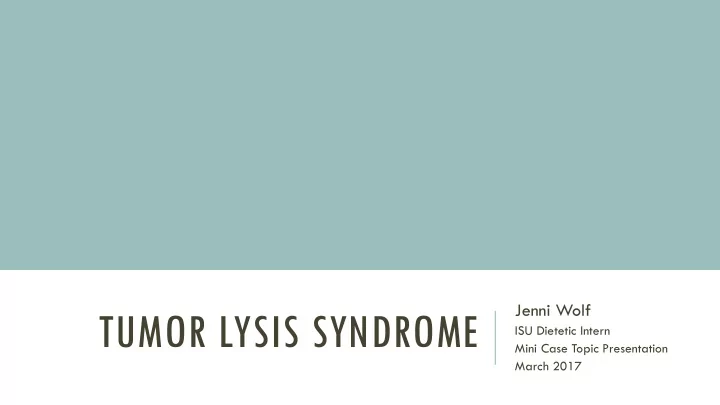

Jenni Wolf TUMOR LYSIS SYNDROME ISU Dietetic Intern Mini Case Topic Presentation March 2017
OBJECTIVES: OUTLINE: ▪ Define tumor lysis syndrome (TLS) and I. Basics of TLS understand its pathophysiology II. Pathophysiology ▪ Identify patients at risk for TLS III. Classification ▪ Understand clinical characteristics of TLS and IV. Metabolic Abnormalities and Clinical current medical treatment Manifestation of TLS ▪ Identify appropriate MNT approach to care for these patients V. TLS Management I. Assessing TLS Risk in Patients ▪ Gain insight into goals of continued tumor II. Treatment lysis research III. Monitoring VI. Relevance to Clinical RDs VII. Future of TLS Research
TUMOR LYSIS SYNDROME: DEFINED ▪ Oncologic condition characterized by: ▪ electrolyte abnormalities ▪ acute kidney injury ▪ cardiac arrhythmias ▪ seizures ▪ death ▪ Occurs most commonly after initiation of cancer treatment via chemotherapy in hematological patients
PATHOPHYSIOLOGY ▪ TLS = direct consequence of the rapid release of intracellular components from lysed cells ▪ Malignant cells are rich in purines , potassium , and phosphorus ▪ Release into ECF ▪ Hyperuricemia, hyperkalemia, hyperphosphatemia, secondary hypocalcemia • Increases serum burden ▪ Rapid onset • 12 -72 hours after initiation of treatment • AKI within 24 hours
CLASSIFICATION ▪ Laboratory TLS ▪ Clinical TLS • Symptomatic clinical manifestations present • Asymptomatic • Only detectable through lab work • ≥ 2 of below abnormalities within 3 days before, or 7 days after, beginning chemotherapy Via American Society of Nephrology
HYPERURICEMIA ▪ Malignant cells contain purines – Adenine, Guanine ▪ Released into ECF ---> uric acid ▪ Uric acid crystallization and blockage of renal tubules ---> risk of AKI • Acute uric acid nephropathy • Increased UA load may affect nephron’s ability to autoregulate • CKD further exacerbates Purines Hypoxanthine Xanthine Uric Acid
HYPERKALEMIA ▪ Rapid release of k+ into ECF ▪ Uptake capacity of liver and muscle is overwhelmed ▪ AKI, CKD further exacerbates the condition ▪ Symptoms: fatigue, muscle weakness, cardiac arrhythmias • EKG/ECG to assess severity
HYPERPHOSPHATEMIA +HYPOCALCEMIA ▪ Massive release of phosphorus into ECF • Malignant cells can contain up to 4x more phosphorus than healthy, normal cells ▪ Clearance moderated by kidney function • Hyperphosphatemia may affect nephron’s ability to autoregulate • Exacerbated by AKI, CKD ▪ Symptoms: nausea, vomiting, diarrhea, fatigue and lethargy ▪ Phosphate binds calcium ions ---> secondary hypocalcemia • Calcium-phosphate precipitates when solubility product is exceeded contributing to AKI
ACUTE KIDNEY INJURY ▪ Urate nephropathy = most common cause ▪ Additional contributing mechanisms to reduce kidney function within TLS: • Calcium-phosphate precipitates • Volume depletion – promotes acidic pH, decreasing solubility of UA • Cytokine-mediated responses and changes • CKD • Hx of AKI ▪ AKI further exacerbates the key electrolyte abnormalities of TLS and therefore renal function is the focus of prevention and treatment measures
N Engl J Med.
TLS MANAGEMENT ▪ “The best treatment is prevention.” • Screening • Prophylaxis • Treatment • Monitoring
SCREENING: WHO’S AT RISK? ▪ Hematological malignancies • Acute lymphoblastic leukemia • Non-Hodgkins lymphoma • Burkitt’s lymphoma ▪ Advanced stage malignancies ▪ Advanced age ▪ Medication use ▪ NSAIDs, angiotensin receptor blockers, ACE inhibitors ▪ Dehydration
Via American Society of Nephrology
PROPHYLAXIS & TREATMENT ▪ Attention to renal function ▪ Hydration – cornerstone of TLS management ▪ IV volume expansion for all patients 2 days prior to tx ▪ Hydration to achieve target urine output of ≥ 2 mL/kg/h ▪ Pt at risk for volume overload may require loop diuretics ▪ Pharmacotherapy if intermediate or high risk ▪ Allopurinol ▪ Rasburicase • Allantoin is 5-10x more soluble than UA ▪ Febuxostat
N Engl J Med.
PROPHYLAXIS & TREATMENT ▪ Electrolyte management • Reduce/remove k+ and phosphorus from TPN, TF, PO intake during time of risk • Phosphate-binders • Kayexalate or hypertonic glucose + insulin • Hypocalcemia NOT treated unless severe and symptomatic • Frequent monitoring ▪ Renal Replacement Therapy ▪ Intermittent hemodialysis ▪ Continuous renal replacement therapies ▪ May begin RRT prophylactically – hx of AKI or CKD
MONITORING ▪ Essential aspect of TLS prevention and management ▪ Interdisciplinary approach: oncology, ICU team, nephrology, cardiovascular, nutrition ▪ Monitor labs and assess renal sufficiency prior to, during , and after treatment • Urine output • Electrolytes • UA ▪ Frequency dependent on risk severity
RELEVANCE TO CLINICAL RD S ▪ Assess nutritional status and risk for malnutrition ▪ Diet restrictions • Evaluate, formulate and identify appropriate TPN, TFs, supplements • Diet education ▪ Electrolyte monitoring ▪ Fluid status ▪ Interdisciplinary team member
LOOKING AHEAD: THE FUTURE OF TLS RESEARCH ▪ Crucial to develop universal, standard definition and diagnostic criteria ▪ Improve risk assessment and identification ▪ Specific nutritional needs – protein ▪ Incidence of TLS • Spontaneous, radiation, solid tumor patients
REFERENCES Belay, Y., Yirdaw, K., & Enawgaw, B. (2017). Tumor lysis syndrome in patients with hematological malignancies. Journal of Oncology, 2017 , 1-9. http://doi.org/10.1155/2017/9684909 Davidson, M.B, Thakkar, S., Hix, J.K., Bhandarkar, N.D., Wong, A., & Schreiber, M.J. (2004). Pathophysiology, clinical consequences, and treatment of tumor lysis syndrome. Am J Med, 116, 546-554. http://doi.org/10.1016/j.amkmed.2003.09.045 Edeani, A. & Shirali, A. (2016). Chapter 4: Tumor Lysis Syndrome. The American Society of Nephrology. Retrieved from https://www.asn-online.org/education/distancelearning/curricula/onco/Chapter4.pdf Escott-stump, S. (2012). Nutrition and diagnosis-related care (7 th ed.) . Baltimore, MD: Lippincott Williams & Wilkins. Garimella, P.S., Balakrishnan, P., Ammakkanavar, N.R., Patel, S., Patel, A., Konstantinidis , I.,… Nadkarni, G. (2017). Impact of dialysis requirement on outcomes in tumor lysis syndrome. Nephrology, 22, (2017), 85-88. http://doi.org/10.111/nep.12806 Howard, S.C., Jones, D.P., & Pui, C. (2011). The tumor lysis syndrome. N Engl J Med, 364 (19), 1844-1854. http://www.nejm.org/doi/full/10.1056/NEJMra0904569 Mirrakhimov, A.E., Voore, P., Khan, M., & Ali, A.M. (2015). Tumor lysis syndrome: A clinical review. World Journal of Critical Care, 4 (2), 130-138. http://doi.org/10.5492/wjccm.v4.i2.130 National Comprehensive Cancer Network. (2017). NCCN clinical practice guidelines in oncology: B-cell lymphomas. Retrieved from https://www.nccn.org/professionals/physician_gls/pdf/b-cell.pdf The University of Texas MD Anderson Cancer Center. (2016). [Practice algorithm for tumor lysis in adult patients.] Retrieved from https://www.mdanderson.org/documents/for-physicians/algorithms/clinical-management/clin-management-tumor-lysis- web-algorithm.pdf
QUESTIONS?
Recommend
More recommend